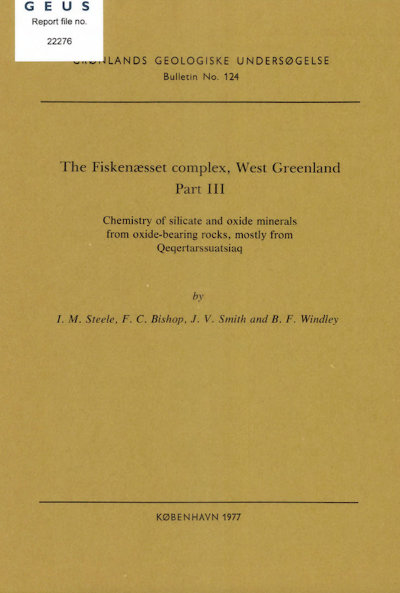The Fiskenæsset complex, West Greenland. Part III. Chemistry of silicate and oxide minerals from oxide-bearing rocks, mostly from Qeqertarssuatsiaq
DOI:
https://doi.org/10.34194/bullggu.v124.6666Abstract
The textures and chemistry of silicates and oxides were investigated for 63 rocks from the Fiskenæsset complex, West Greenland, by light microscopy and electron microprobe analysis. Emphasis was placed on those chemical distributions known to depend on temperature.
Photomicrographs are given for the following intergrowths: spinel-magnetite, chromite-rutile, Cr-magnetite-Al-chromite. Magnetite occurs dispersed throughout Fe-bearing silicates, probably the result of oxidation. Chromite grains in chromitites commonly have a centre rich in inclusions of rutile and amphibole and a clean margin; partial recrystallization of the chromite followed by metamorphic equilibration to give a uniform composition from core to rim is indicated. Magnetite associated texturally with sulphides is Cr-free, and apparently results from oxidation.
Coexisting spinels outline a solvus between (Fe, Mg)Fe2O4 and (Fe, Mg)Al204 which has a critical point near (Mg, Fe)(Fe0.6Al0.6 Cr0.8)O4. The wide tie-lines for Cr-poor specimens indicate equilibration below 500°C.
Coexisting ilmenite and ferromagnesian silicates apparently equilibrated in most rocks near 650 ± ∽100°C, but in ones with late serpentine or tremolite, equilibration was probably below ∽425°C. Coexisting pyroxenes apparently equilibrated at higher temperatures, either near 700 or 850°C depending on which laboratory calibration is used. The Cr-rich spinels from the Fiskenæsset complex are lower in Mg than ones from dry basaltic stratiform complexes, and other chemical features lead to a distinctive composition range as proposed by Ghisler. Further data for the silicates confirm most of the observations and conclusions in Part II, but (a) five specimens were found to contain tremolite apparently in compositional equilibrium with hornblende, (b) highly calcic plagioclase does not necessarily coexist with chromite as was proposed in Part II, (c) some specimens with unusually sodic plagioclase and unusually Fe-rich silicates may represent a cryptic differentiation trend. Although many problems remain for further study, the silicates and oxides are interpreted as the variously metamorphosed products in the granulite, amphibolite or greenschist facies of a moderately wet AI-rich basaltic magma which underwent crystal-liquid differentiation under fairly oxidizing conditions. The original igneous assemblage apparently involved early precipitation of Mg-AI-Ti-Cr-magnetite, prolonged crystallization of highly calcic plagioclase and tschermakitic-magnesiohornblende, and late crystallization of high-Fe, medium-Cr spinel.
Downloads
Published
Issue
Section
License
This article is distributed under a CC-BY 4.0 licence, permitting free redistribution and reproduction for any purpose, even commercial, provided proper citation of the original work. Author(s) retain copyright over the article contents.


